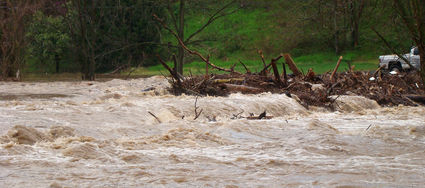When Caliente Creek started swallowing houses and cars
Mountain Tales: First-hand stories of life in Tehachapi
August 31, 2019
In 1983, I was 17 years old and living with my Dad, Mom, sister Joy and brother Brian in an old house in Caliente Canyon. It had been a very wet winter that year, and on March 1, it had been raining really hard for about 3 days. Caliente Creek had risen up and then come back down a few times. Dad left early that morning because he had to be at work in Bakersfield by 6 a.m. My sister Joy had caught the school bus about 6:15. Mom told me, "That water's getting deep, I need you to stay home and help me." So I didn't go to school that day. We had a litter of eight puppies that were German Shepherd and one-quarter wolf, and I brought them into the house, and I fell asleep on the couch by them. We didn't have a phone at our place, and so my Mom went up by Indian Creek to use a neighbor's phone to tell my Dad to come home, because the creek was rising higher than she'd ever seen it. She caught a ride on the high school bus as it went by on Caliente Creek Road, and got off the bus near a bridge by the neighbor's house. She didn't make it across the bridge, though, because water was lapping over it and she was afraid if she crossed it she wouldn't make it back across the bridge to get home, and she knew I was asleep.
The bus was still making the route because the driver, John Denver, wasn't intimidated by water in the road at the creek crossings – Mr. Denver had Tommy Garcia keep an eye on the water as it came in through the front door of the bus when we'd dip down at creek crossings, and had Tommy tell him when the water reached the second step. As long as it only reached the first step, we'd go on through.
When my Mom walked back from trying to use the phone, she got Brian and woke me up and said, "We're leaving." We walked up the hill behind our house and watched the creek keep rising. It wasn't even raining on us by this point, but it had rained so much earlier the water was continuing to come up. It had snowed a lot that winter, too, and the rain was melting the snow at the higher elevations and that was contributing water to the creek, too. Plus Indian Creek and Caliente Creek come together not far from our house, so there was the combined water of both of them. Pretty soon we saw a 1970s LTD owned by our neighbor, Turk, float downstream. The creek was wall-to-wall, from one side of the canyon to the other, by this point. Then we saw his Ford truck carried downstream, then his doublewide mobile home. It floated, then slowly spun around in the water, and when it hit the big culvert a little downstream, it just shattered. The trailer was so broken up it looked like toothpicks when it shot out the other side of the culvert. Then I saw our barn go, and then our house. It tipped over on its side, and then collapsed on itself. It made a horrible crashing sound. We lost all our dogs, cats, everything we owned. We raised wolves at that time, and some of them survived. At least one was shot by a neighbor who claimed he was chasing cattle. We had an adult female Tundra wolf named Tunnie, an adult male Timber wolf named Wolfie, an Asian wolf, a coyote, and a wolf pup that we had bottle-fed from the time he was ten days old.
We walked from the hill above where our house had been to a cabin near Indian Creek. My Mom, my brother and me stayed at that cabin with the owner, as well as some neighbors, Barbara and Bill Lawrence. We were stuck there for two days, and military rations were dropped to us from a helicopter. I remember them not tasting very good. After two days, we got picked up in a helicopter, and they said they'd take us wherever we wanted to go. I said, "Bakersfield!" but my Mom wanted us to go over to our friends house near Back Canyon, to Harry and Bonnie Heflin's place. Then we were trapped there for two weeks. Nobody was killed in the flooding, fortunately, but a number of families lost their houses – us, the Goodmans, Shorts, Turners, Turk and others. A couple of empty or weekend houses washed away, too. Don and Louise Hawkins, who were farther down the canyon, lived in their tree house for months until they could restore their house. Nobody in our part of the canyon rebuilt – they told us that where our house had been was a flood zone and we couldn't rebuild. Our property was 20 acres of mostly straight up and straight down, and only about an acre of flat ground, and that was all sand. Caliente Creek Road had gone from being entirely paved to being mostly a dirt road, with 52 creek crossings. It was officially closed for more than a year afterward, though residents would still use it. But with the lost houses and road problems, there were about ten families that just moved away and didn't come back.
– Julie Girado Turner
Julie Girado Turner is a Nuwä tribal member and one of the founders of the Kawaiisu Language and Cultural Center. She was born in Kern County and is a Tehachapi resident.






